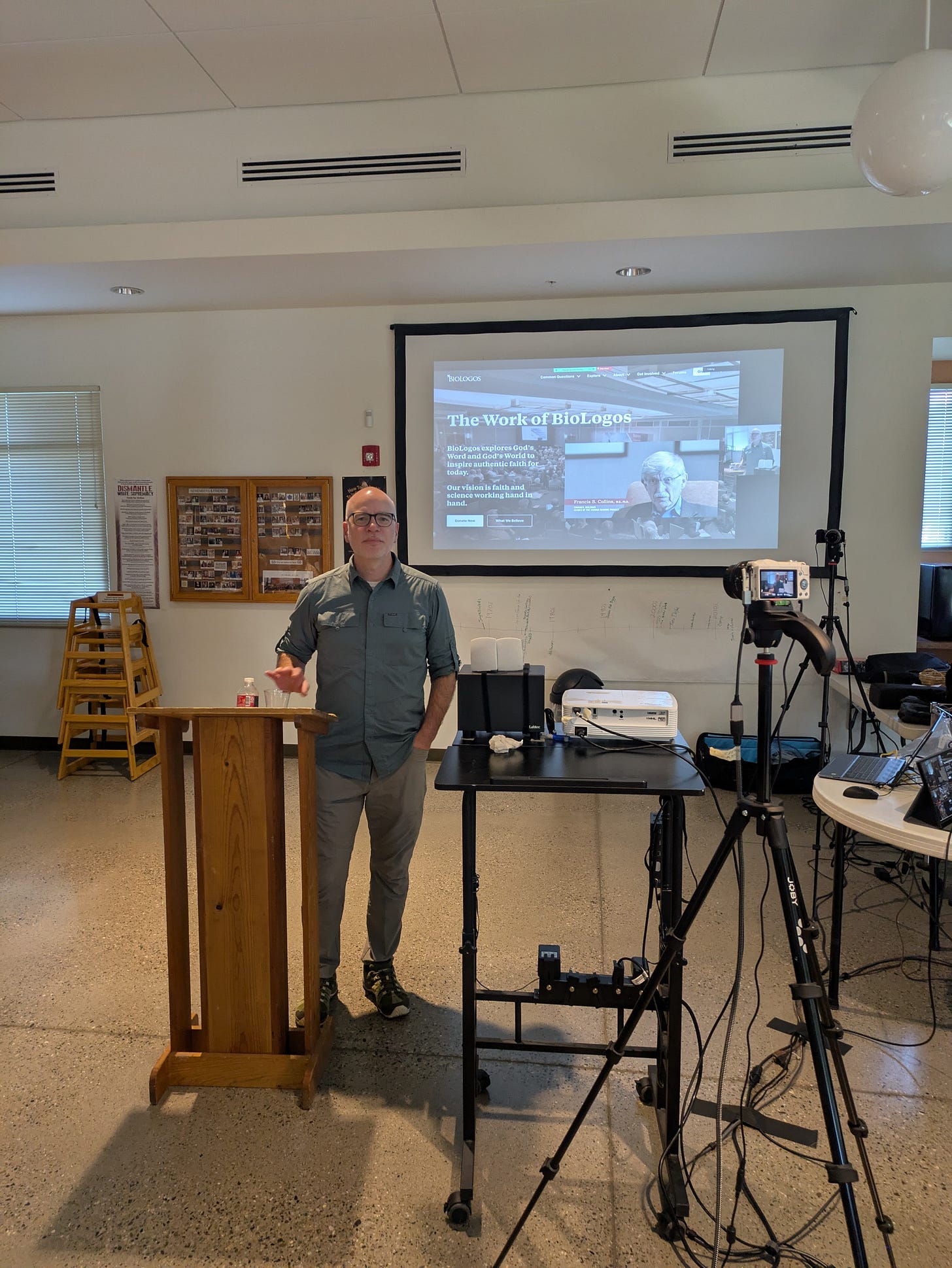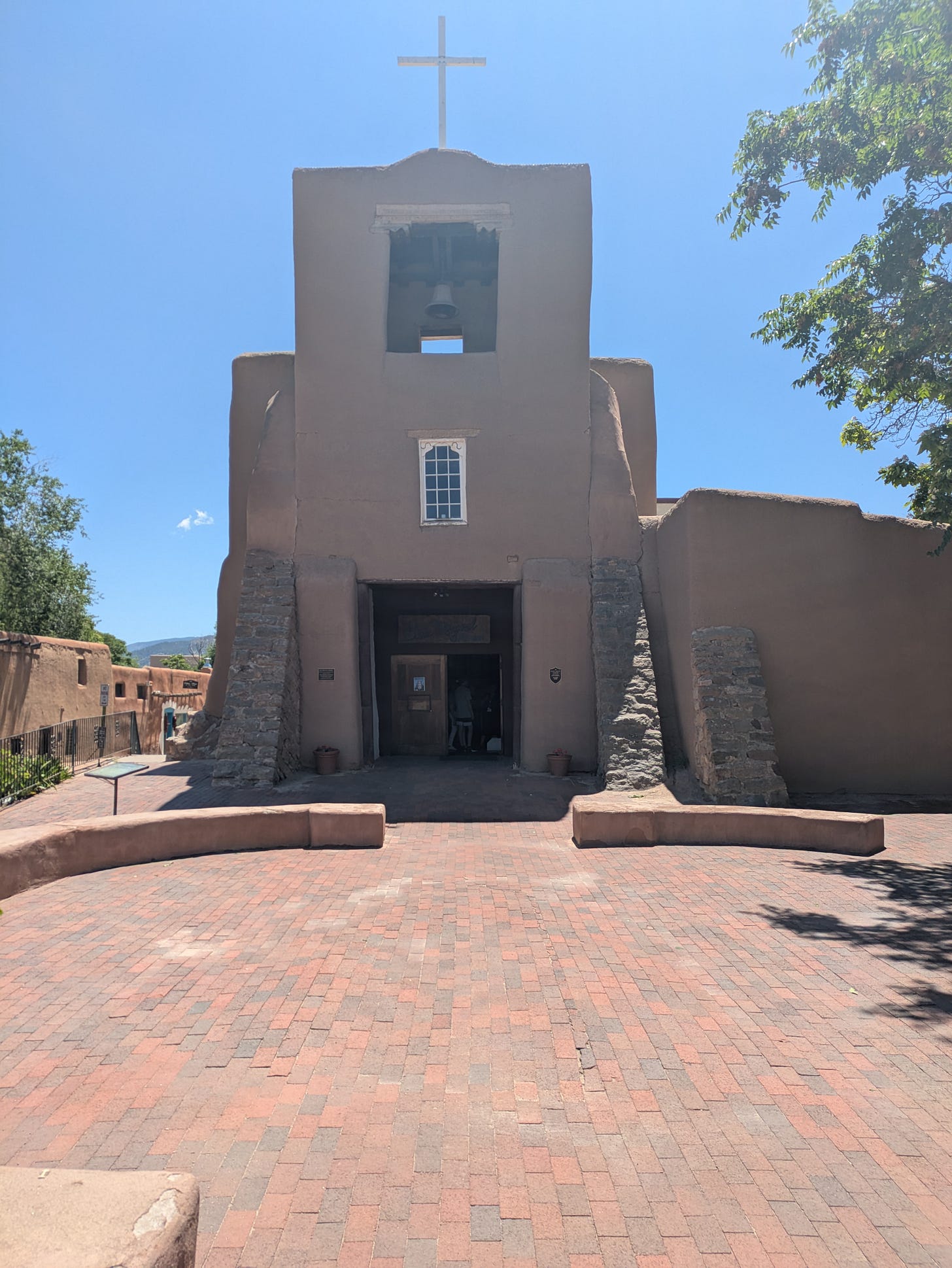I’m sure you’re all dying to know if I persuaded everyone of the correct answer to the question in my presentation on Tuesday night: Did God Guide Evolution? I’m happy to report that, yes, it seems that I did. At least no one convinced me that I am wrong (which is usually the way these things go).

So this was the Science and Faith club at Los Alamos. That means most of the people there were scientists affiliated with Los Alamos National Laboratories. But somehow it took about 5 of them more than 30 minutes to figure out how to make the technology work for connecting my computer (a Mac) to their projector (which was routed through a PC for broadcasting to the web). But we ended up having a good time. I spoke there again last night on the topic of the book I’m working on, “The Spiritual Journey of Homo Sapiens.” It was a fun group.
During the day yesterday, a friend from the BioLogos discussion community picked me up and took me to Bandelier National Monument. There we saw the remnants of a civilization that flourished in a valley about 800 years ago by building homes nestled up against the cliff wall and making caves in those same walls. They also left behind some petroglyphs on the walls. As usual, I’m enchanted by standing in the place were people did so long ago and thinking about what it must have been like to be them.


From there, we went into Santa Fe and saw, among other things, the oldest church in America. The Spanish came up from Mexico looking for cities of gold, but ended up settling for trying to convert the Native Americans and founded this church in 1610.
Then we went on a pilgrimage. Well, not exactly, but we went to a pilgrimage site: the Santuario de Chimayo. The story is that back in the 1800s, a local farmer was digging and found a cross buried underground. He took it to the local priest, but then the next day the cross had disappeared from the priest’s possession. Upon further investigation, they found it again at the very place it was first discovered. They took this as a sign that they should build a shrine and found a church there on that obviously holy dirt. Since then, pilgrims come walking there by the tens of thousands during Easter week, and there are numerous reports of miraculous healings when the afflicted touch the holy dirt.
I am (of course) a tad skeptical of such claims, but find the spectacle pretty fascinating. We drove there (which might negate the miraculous effects) to walk around the grounds a bit and poked our heads into the chapel. But then we made it to the shrine where the holy dirt is. There were lots of crutches in the anteroom, where people had purportedly hobbled in on them, and then were healed and left them behind. I wondered if it was only people who had the big maladies, like the lame and the blind, who were eligible for healing there. I thought it would be easier to test the efficacy of the dirt with something less spectacular. So I put some of it onto the wart on my finger that I haven’t been able to get rid of, thinking I’d leave behind my bottle of Compound W in the anteroom next to the crutches. But alas, it’s still there.
That probably sounds like I’m making fun of the cult of Chimayo… and I suppose I am a little bit. But I talked about it with my group of scientists last night, and one of them was quite sure the miracles were real. She told me, if enough people believe in something like that, it becomes real to them. That reminds me of Jesus’s words in Mark chapter 9 when he tells a guy whose son was having seizures and the disciples couldn’t help him. But Jesus said, “anything is possible for one who believes.” The father responded with what I think is the most honest declaration in scripture (in the King James Version), “I believe; help thou mine unbelief.”
My last stop before the evening session with the scientists was to see a little more of Los Alamos. There was a flier in my hotel about taking the “Oppenheimer” tour, but I discovered most of the movie was filmed on Georgia O’Keeffe’s ranch instead of in the city, because the city looks too modern now with its McDonalds and Starbucks. But there is still a “historic” section with several landmarks. One of those is an original building that bills itself as the place where the first atomic bombs were assembled. I wouldn’t say that I was “enchanted” standing in the very place where people did a couple of generations ago and created these incredible mechanisms of death and destruction. Oppenheimer supposedly quoted the Bhagavad Gita upon the successful test of the bomb, “I am become Death, the destroyer of worlds.”
Instead of thinking about what it would have been like to be them back in the 1940s, I stood there and wondered what things would have been like today if they hadn’t built the bombs and became Death. I’d like to believe we would have been OK.






Reading Hampton Sides’ “Blood and Thunder” right now. It gives a fantastic historical perspective of the area you write about here.
I’d like to hear a summary of your talk!
That was a fun day! Sorry I'm slow, but I enjoyed reading your reflections on New Mexico's connections to modern and ancient history. I tend to think the atomic bomb would've been invented eventually no matter what, but who knows what the context might've been, for better or worse.
Couldn't think of a better summary of Chimayo or the life of faith: “I believe; help thou mine unbelief.”